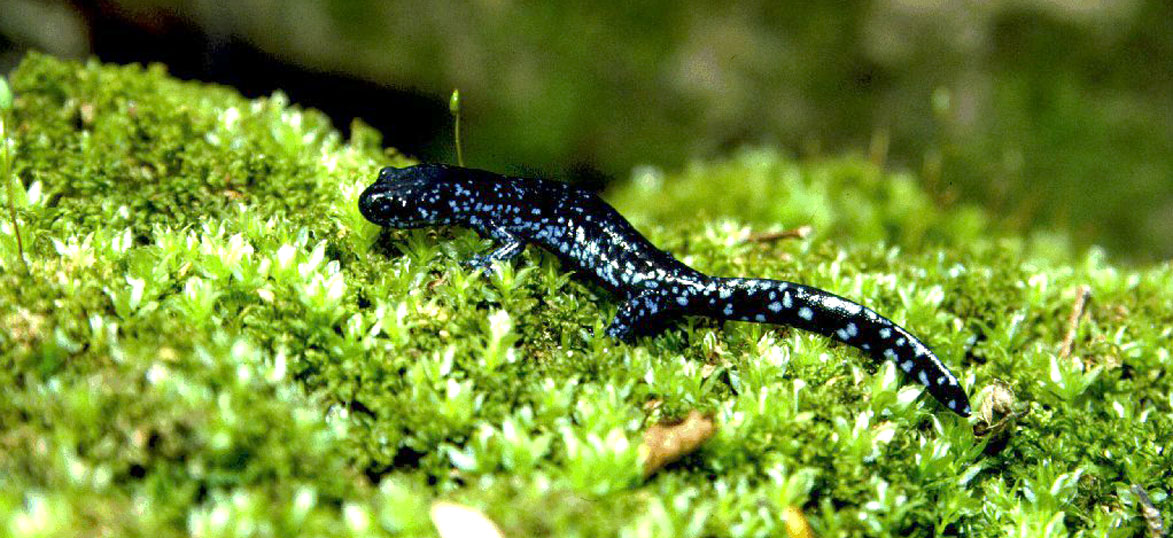
The Blue-spotted salamander (Ambystoma laterale) is the smallest of Vermont's three mole salamanders. They grow to five inches long and are black with small light blue spots on their backs and sides.
Field guides or identification books often comment that the coloring of Blue-spotted salamanders resembles old-fashioned enamel cookware.
Habitat
Roughly 360 million years ago, the first vertebrates heaved themselves out of the ocean to begin life on land. These animals were amphibians. Although there were once 15 major groups of amphibians, today only three remain: frogs and toads, salamanders, and wormlike animals called caecilians found only in the tropics.
Salamanders, like other amphibians, have not entirely broken free of their tie to water. All Vermont salamanders, except for the Redback salamander, must return to the water for some part of their life.
Salamanders need the moisture found in wetlands and on the cool forest floor to keep their skin wet to prevent them from drying out. Typically, salamanders hide in damp, cool places during the day and only venture out in the cooler night air.
Blue-spotted salamanders are found in lower elevations in or near flood plains, semi-permanent pools, marshes, shrub swamps, or forested red maple/cedar swamps. It is found primarily in the Champlain lowlands with scattered populations elsewhere.
Jefferson, Blue-spotted, and the Spotted salamanders are all part of the same family commonly called mole salamanders. They live in the cool woods, in crevices, under leaves, rotting wood, rocks, or old stone walls, and in the burrows of small mammals. They primarily live underground except during mating season.
Reproduction
Blue-spotted salamanders have historically hybridized with Jefferson salamanders and a wide variety of hybrids can be found. This sometimes makes identification difficult.
Pure Blue-spotted salamanders lay single gelatinous eggs but hybrids reportedly deposit masses with up to 12 eggs.
Most of Vermont's salamanders spend part of their life in water, and part of it on land. Salamanders have an intricate courtship ritual.
During late March and early April, male and female Spotted salamanders migrate to vernal pools to begin their elaborate and energetic mating dance. They nudge each other with their snouts and then rub against each other. The salamanders will then intertwine and entangle their legs and tales, and roll and wrestle.
Eventually the male drops white spermatophores in shallow water. This spermatophore is the sperm packet. The female takes the spermatophores up into her cloaca, allowing her eggs to be fertilized internally.
After a wait of several days, she will lay 150 or so eggs in a single mass. The eggs are attached to vegetation in shallow water. One female usually lays two or three egg masses.
Depending on springtime temperatures, the eggs will hatch in one or two months. The small larvae live in the water for 70 to 100 days, when they transform into small adults, and leave the water. This year's young will breed next spring.
Diet
Salamanders eat beetles, earthworms, slugs, spiders, mites, mosquito larvae, and occasionally each other. Aquatic salamanders will also eat small minnows.
Management
During the past few decades, more has been learned about salamander populations and their natural histories in Vermont. A reptile and amphibian atlas project initiated in 1995 has provided more information on the distribution of Vermont's salamanders.
Biological inventory of wildlife and natural communities is helping identify important habitats and vulnerable populations of salamanders in order to include these in conservation planning efforts. A study of vernal pools is providing information on habitat characteristics that are important for salamander breeding.
Large-scale land conservation projects, such as the addition to public lands in the Nulhegan River Basin, are helping to ensure the continued existence of salamanders in Vermont's landscape. Environmental legislation also helps sustain vulnerable species of salamanders by protecting their critical habitats.
Status
Salamanders are incredibly abundant in Vermont, but despite this multitude, total salamander numbers are decreasing. Loss of vital habitat, like vernal pools, is contributing to their declining numbers.
The Blue-spotted salamander is a species of special concern in Vermont.
